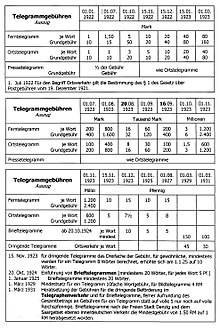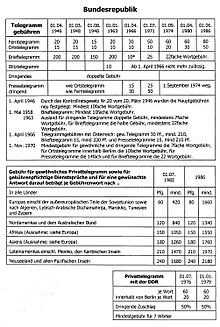telegram
A telegram (from the Greek tele : fern, far and gramma : letter, writing; literally telex or telex ) is a telegram transmitted message with the help of acoustic , optical or electrical devices. Telegrams were mostly transmitted by telex . Today (as of August 2020) they are hardly used anymore. Since the fee (previously fee) for a telegram is based on the number of words, a so-called telegram style has become established, e.g. For example, instead of saying “I will arrive on Friday at 5:00 p.m.”, the shorter “Arriving Friday 5:00 p.m.”, recipients could also request an abbreviated address, the “ wire word ”. Telegrams can still be delivered from the post office on decorative cards.
The expression telegram was coined in 1852 by EP Smith from Rochester ( United States ), who only replaced the common expression "telegraphic despatch " much later . Other terms were cable (or the verb kabeln derived from it ) or wire message , which referred to the transmission path .
The confidentiality of letters also applies to telegrams, i.e. H. the accepting employee may neither pass on the content to others nor falsify it.
Background / transmission
Telegrams were a sensible facility at the end of the 19th and beginning of the 20th century because there were hardly any (private) telephones . Since the standard letter transit time was approx. 4 days, telegrams were the only way to deliver messages comparatively quickly.
A telegram was transmitted in three stages:
- Send a telegram: The sender dictated his text to an official in the post office or telegraph office either in person or by telephone. He noted the recipient's address, the actual text and a possible decorative motif (the templates were hanging or were printed in the telephone book). You could pay either in the office, by telephone bill or by inserting coins on the public telephone . During the heyday of telegram usage in Germany , the postal service, telephone service and telegraph service were combined under one roof ( Reichspost , Bundespost or Deutsche Post of the GDR ). This made the diverse, equal access possible. In business transactions it was common (as early as 1900) to have a telegram address (stored at the telegraph office) : It was a word with up to 15 letters. If a sender used this address, they only had to pay a word fee for it, otherwise they would pay a word fee each for name, street, house number and city.
- Send telegram: The noted information was then z. B. sent by telex to a post office or telegraph office in the vicinity of the recipient .
- Delivering the telegram: At the receiving office, the telegraph paper strip was stuck into a card (e.g. the selected jewelry card) and delivered by (motorcycle) messenger, usually within two hours (4 hours at night) after the telegram was posted.
Telegram service by country
Germany
In 1870 it was possible to send telegrams to India.
The first picture telegram was sent and received in 1927 in the trial operation of picture telegraphy between the large Nauen radio system and the receiver at the Telefunken headquarters in Brunnenstrasse in Berlin-Wedding. The first international transmission took place in 1930 from Berlin to Nanjing, China, via shortwave . In 1978, according to the Deutsche Bundespost, around 13 million telegrams were sent.
Since December 31, 2000, Deutsche Telekom AG has stopped sending telegrams abroad. This is justified by the fact that the transmission route is technically outdated. The “Telegram” service will continue to be offered in Germany by Deutsche Post AG . It offers the possibility to send private greetings with an individual touch. There are also various Internet services that offer the sending of telegrams - also abroad. This “modern” form of telegram can only be compared to the previous one to a limited extent: some of the delivery - at Deutsche Post, if posted after 3:00 am - is not until the next working day, no longer within hours. The telegram has lost its importance as the communication network has been expanded and more modern data transmission options ( SMS , e-mail , instant messaging ) are now available.
Austria
A telegram was sent for the first time in Austria in 1847. Up to the outbreak of the First World War , the number of telegrams sent annually grew to 23 million in 1913. The competition from telephone , radiotelephone and telex that began a little later led to a decline in the use of telegram services from the 1920s. Until the end of the 20th century, however, congratulatory telegrams with pictures or with music in particular enjoyed even greater popularity. In 1984 a total of around one million telegrams were sent in Austria.
With the spread of e-mail and mobile telephony , telegrams finally lost their importance as a fast information service since the 1990s. So that gave Telekom Austria on 24 October 2005 known for economic reasons (only considerably less than 10,000 messages sent per month) this service on December 31 completely set. From January 2006 UTS GmbH (telegramm.at) took over the telegram service from Telekom Austria.
This company also took over the telegram service in Switzerland in 2005 and owns and operates the telegram services in a total of 43 countries, including the Netherlands, Austria, Great Britain, Sweden, Poland, New Zealand, Hong Kong and Singapore.
United States
On January 27, 2006, Western Union , once the leader in telegram transmission, shut down due to lack of demand. In 2005, 30 employees were still responsible for this business, but a total of only 20,000 telegrams were sent (for comparison: in 1929 there were 200 million).
Thailand
At the end of April 30, 2008, the telegraph network in Thailand was shut down. It had been in operation since 1875.
India
The Telegram Service was founded in 1850 by the East India Company . On November 5, 1850, the young Irishman William Brooke O'Shaughnessy sent the first telegram - from Calcutta to Diamond Harbor, a few kilometers away. In the year of independence from England in 1947, 20 million messages were sent with it, in 2012 only 40,000, although the population has quadrupled to 1.2 billion. On July 15, 2013, India ended the telegram service after 163 years. Most recently there were 75 telegram offices and the responsible ministry for telecommunications employed almost 1,100 telegraph operators. Telegrams were always delivered personally by messenger. The employees are to be deployed in other areas of Bharat Sanchar Nigam Limited . Until the introduction of an internet-based telegram service system in 2008, transmission was often carried out using Morse code telegraphy ; teleprinters were only used sporadically.
Other meanings in special fields
Computer science
The term data telegram (also known as datagram ) is often used in computer science . Although they are used to transmit messages, they are not telegrams in the classic sense. Data telegrams are standardized data sets that are transmitted digitally (and typically serially ) and are mostly used for remote control and control purposes in system automation. For example, the bit information that the DCF77 time signal transmitter sends within one minute forms a telegram. See also under data package .
Railway engineering
The data transmission between line equipment ( LZB line conductor, balise ) and vehicle equipment (LZB aerial, balise aerial / loop) is used as an application for information technology telegrams .
See also
Web links
- Off for telegrams in Austria to heise online from November 1st, 2005
- Internet and mobile phones are killing international telegrams heise online from September 1, 2000
- Swiss Post press release of January 14, 1999
Individual evidence
- ↑ E. Smith Peshine
- ↑ http://www.joern.de/Indolinie.htm accessed on October 18, 2019
- ↑ heise online: Internet and cell phones put an end to international telegrams from September 1, 2000
- ↑ tariftip.de: Deutsche Telekom discontinues international telegrams from September 2, 2000
- ^ Telegram service of the Deutsche Post AG
- ↑ UTS GmbH (accessed April 29, 2016)
- ↑ Thailand switches off telegraphy service after 133 years: on dernewsticker.de (content is no longer available)
- ^ The end of the telegram , Tages-Anzeiger of July 12, 2013
- ↑ India abolishes telegrams after 162 years , ORF.at of July 12, 2013
- ↑ The last telegram . In: Die Welt Kompakt , July 16, 2013, p. 32.
- ↑ Dr. P. Jayendira Sankar, Dr. G. Yoganandham ISBN 9781365223143
- ↑ BSNL Circular 6859/10





